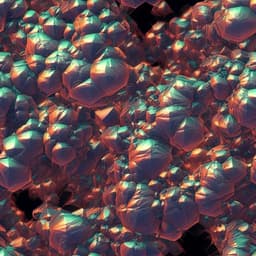
Engineering and Technology
Blocking lithium dendrite growth in solid-state batteries with an ultrathin amorphous Li-La-Zr-O solid electrolyte
J. Sastre, M. H. Futscher, et al.
Discover how amorphous Li₇La₃Zr₂O₁₂ (LLZO) acts as a formidable dendrite shield in solid-state batteries. With extraordinary enhancements in ionic conductivity and impressive cycling capabilities, this research by Jordi Sastre, Moritz H. Futscher, Lea Pompizi, Abdessalem Aribia, Agnieszka Priebe, Jan Overbeck, Michael Stiefel, Ayodhya N. Tiwari, and Yaroslav E. Romanyuk promises to propel battery technology forward.
~3 min • Beginner • English
Introduction
The study addresses the critical challenge of lithium dendrite formation in solid-state batteries employing lithium metal anodes and garnet-type solid electrolytes such as LLZO. Although LLZO offers high ionic conductivity (~10⁻³ S cm⁻¹) and a wide electrochemical stability window, its polycrystalline nature, surface/bulk defects, and non-negligible electronic conduction along grain boundaries promote Li nucleation and dendrite penetration, causing short circuits. Prior work suggests that amorphizing the LLZO surface can improve dendrite resistance by suppressing electron injection, but methods like laser annealing provide limited control over the amorphous layer’s properties. This work hypothesizes that a deliberately engineered amorphous Li-La-Zr-O (aLLZO) thin film with tuned Li content can provide a grain-boundary-free, electronically insulating yet ionically conductive interlayer/electrolyte to suppress dendrite growth, improve interfacial contact with Li, and enable ultrathin solid electrolytes for microbatteries. The purpose is to understand structure–transport relationships in aLLZO, optimize ionic/electronic conductivities, and demonstrate practicality as a dendrite-blocking coating on crystalline LLZO and as an ultrathin electrolyte in thin-film batteries.
Literature Review
LLZO is a leading oxide solid electrolyte for Li metal solid-state batteries due to high ionic conductivity and electrochemical stability, yet dendrites are linked to grain boundary pathways and electronic leakage (Porz et al.; Han et al.; Song et al.). Laser-induced amorphization of LLZO surfaces increased critical current density (CCD) by impeding electron injection (Kim et al.), but lacks precise compositional control. Prior thin-film studies prepared amorphous Li-La-Zr-O by RF sputtering (Kalita et al.) and PLD (Garbayo et al.), observing ionic conductivities around 10⁻⁷ S cm⁻¹ and relationships with Li content and glassy states, yet without demonstrating device-level dendrite suppression or battery operation. Glassy electrolytes like Li₃PO₄ and LiPON have shown dendrite suppression. This work builds on these insights by controllably depositing and compositional-tuning aLLZO, characterizing its transport, and applying it as both coating and ultrathin electrolyte.
Methodology
- Film synthesis: Amorphous Ga-doped Li-La-Zr-O (aLLZO) films deposited at room temperature by RF magnetron co-sputtering from Li₆.₂₅Ga₀.₂₅La₃Zr₂O₁₂ and Li₂O targets in Ar with trace O₂ (0.3 Pa). The relative sputter powers controlled the LLZO:Li₂O mass fraction. Typical optimized conditions: 1.5 W cm⁻² (LLZO) and 7.6 W cm⁻² (Li₂O), yielding ~70 nm thick films.
- Substrates and electrodes: For structural/chemical analysis, MgO (100) single crystals; for electrical measurements, Pt/Ti/MgO/Si substrates with Au top contacts; for Li half/symmetric cells, Pt-coated sapphire or evaporated Li on sapphire. All handling in Ar glovebox; Li contacts evaporated and capped with Cu without air exposure.
- Structural/chemical characterization: Cross-section SEM; gas-assisted FIB-TOF-SIMS 3D tomography to map element distributions; GI-XRD to confirm amorphous phase (broad hump vs crystalline LLZO references); Raman spectroscopy identifying dominant Li₂O₂ vibration (~800 cm⁻¹) and absence of LLZO crystal modes; FT-IR ATR confirming oxide bonding (Zr–O, La–O, Li–O) and absence of carbonate/hydroxyl features. A glass-network model with disordered Zr–O/La–O chains and mobile Li cations is proposed.
- Transport measurements: Through-plane EIS (100 mHz–10 MHz) with blocking electrodes to extract ionic conductivity and activation energy (Arrhenius analysis). Temperature-dependent EIS up to 200 °C. Current transient experiments after long pre-bias to quantify mobile Li⁺ density; mobility computed from σ = qnµ. Electronic conductivity measured from steady-state current 1 h after ±1.2 V bias; activation energy extracted.
- Li stability tests: Pt/aLLZO/Li half-cells cycled galvanostatically (±1.25 µA cm⁻²) around 0 V vs Li/Li⁺ with EIS monitoring after each step to assess interfacial/electrolyte stability. Symmetric Li/aLLZO/Li cells cycled with increasing current densities 0.2–3.2 mA cm⁻², five cycles each, capacity limited to 0.1 mAh cm⁻² per step.
- Dendrite-blocking coating on bulk LLZO: 0.5-mm-thick crystalline Ga-doped LLZO pellets (cleaned at 400 °C in O₂) coated on both sides with 10 nm aLLZO. Through-plane symmetric Li/LLZO cells assembled; room-temperature EIS used to separate bulk and interfacial resistances. Galvanostatic plating/stripping with stepwise current 5 μA cm⁻² to 5.1 mA cm⁻² without external pressure to determine CCD.
- In-plane operando visualization: Half of the LLZO pellet coated with 10 nm aLLZO, the other uncoated. Evaporated Li/Cu contacts with 0.5 mm spacing; applied currents 50 μA cm⁻² to 3.2 mA cm⁻² for total 25 μAh cm⁻²; operando optical microscopy to observe filament nucleation/propagation.
- Thin-film microbattery: Stack on Pt-coated sapphire: 320 nm sputtered LCO (annealed 700 °C), 10 nm LiNbO₃ protective coating (reactive co-sputter), 70 nm aLLZO electrolyte, 2 μm Li anode. Galvanostatic cycling 3.0–4.25 V with 1C = 22 μA cm⁻²; rate capability up to 10C (0.22 mA cm⁻²) and long-term cycling at 10C for 500 cycles. Cyclic voltammetry used to assess oxidative stability of aLLZO against LCO.
Key Findings
- Amorphous structure: GI-XRD shows amorphous hump; Raman indicates dominant Li₂O₂ band (~800 cm⁻¹); FT-IR shows oxide bonds without carbonate/hydroxyl signatures; films are dense and conformal (~70 nm).
- Tunable transport via Li₂O addition: At 300 K, ionic conductivity increases by ~3 orders with added Li₂O, peaking at ~1 × 10⁻⁷ S cm⁻¹ for LLZO:Li₂O mass fraction ≈0.66; electronic conductivity remains ~1 × 10⁻¹⁴ S cm⁻¹ across compositions (≈7 orders lower than σ_ion at optimum). Temperature-dependent analysis shows increased mobile Li⁺ density and reduced activation energy with Li₂O up to the optimal fraction; mobility increases accordingly. Above the critical fraction, aggregation limits further gains.
- Lithium stability and high-current operation: In Pt/aLLZO/Li half-cells, electrolyte resistance slightly decreases initially then stabilizes during repeated plating/stripping near 0 V, indicating interfacial/electrolyte stability with Li. Symmetric Li/aLLZO/Li cells exhibit stable polarization up to 3.2 mA cm⁻² with no voltage drop to 0 V or large fluctuations, indicating no short circuits at transferred capacity of 0.1 mAh cm⁻² per step.
- Dendrite-blocking coating on bulk LLZO: 10 nm aLLZO coating reduces interfacial resistance by about 50% relative to uncoated pellets. The CCD increases from 0.32 mA cm⁻² (bare LLZO) to 1.3 mA cm⁻² (aLLZO-coated), a 4× improvement; microshorts in the coated sample only appear near 2.6 mA cm⁻², with stable overpotential up to 0.64 mA cm⁻².
- Operando visualization: In an in-plane geometry, the uncoated side shows spiky voltage indicative of microshorts and forms a Li filament bridging contacts at 1.6 mA cm⁻². The aLLZO-coated side maintains stable polarization without observable Li filaments under the same conditions.
- Ultrathin electrolyte microbattery: A 70 nm aLLZO electrolyte enables LCO/Li microbatteries showing a 3.9 V plateau, modest overpotentials (~50 mV at 1C), and high-rate capability: 55 μAh cm⁻² μm⁻¹ at 1C (~110 mAh g⁻¹), and 39 μAh cm⁻² μm⁻¹ at 10C (~70% of 1C capacity). Long-term cycling at 10C for 500 cycles retains ~60% capacity with ~97.6% Coulombic efficiency; no signs of short circuiting despite ultrathin electrolyte.
- Electronic blocking: The low electronic conductivity of a 10 nm aLLZO interlayer corresponds to very high area-specific electronic resistance, suppressing electron injection and favoring homogeneous Li nucleation at interfaces.
Discussion
The results demonstrate that an amorphous, grain-boundary-free Li-La-Zr-O layer can decouple ionic and electronic transport at Li interfaces: ionic conduction is sufficient for interfacial charge transfer and microbattery operation, whereas electronic conduction is suppressed by ~7 orders of magnitude, mitigating electron-driven Li nucleation within the electrolyte. Tuning the Li content via Li₂O co-sputtering increases mobile Li⁺ density and lowers activation energy, improving σ_ion to ~10⁻⁷ S cm⁻¹ while preserving very low σ_e. As an ultrathin coating on crystalline LLZO, aLLZO reduces interfacial resistance (improved wettability/homogeneous nucleation) and markedly increases CCD, directly addressing dendrite penetration pathways associated with grain boundaries and electronic leakage. Operando visualization corroborates the suppression of filament formation under high polarization when aLLZO is present. As a standalone electrolyte, the 70 nm aLLZO enables high-rate, long-life microbattery operation without shorting, underscoring its robustness against dendrite-induced failure. Compared with in situ laser amorphization, sputtered aLLZO offers precise composition and thickness control, enabling optimization for dendrite blocking and device integration. The need for a cathode-side protective layer (LiNbO₃) highlights oxidative stability considerations tied to excess Li species, which can be engineered in future designs.
Conclusion
This work establishes amorphous LLZO (aLLZO) as an effective dendrite-blocking interlayer and as an ultrathin solid electrolyte (<100 nm). Controlled co-sputtering with Li₂O tunes Li content to maximize ionic conductivity (~10⁻⁷ S cm⁻¹) while maintaining negligible electronic conductivity (~10⁻¹⁴ S cm⁻¹). aLLZO-coated crystalline LLZO pellets exhibit ~4× higher CCD and reduced interfacial resistance, and in-plane tests show suppression of Li filament formation. As a 70 nm electrolyte in thin-film LCO/Li cells, aLLZO supports 1–10C operation and 500-cycle stability without short circuits. These advances suggest aLLZO coatings can enhance the safety and performance of ceramic-electrolyte solid-state batteries with Li metal anodes. Future work should integrate aLLZO coatings into full bulk solid-state cells, optimize oxidative stability and interfacial chemistries (e.g., via protective layers or composition tuning), and further increase ionic conductivity while preserving electronic insulation.
Limitations
- Oxidative stability: Excess Li (e.g., Li₂O) in aLLZO likely limits stability above ~3 V vs Li/Li⁺, necessitating a protective LiNbO₃ layer at the cathode side in microbatteries.
- Capacity fade: Thin-film cells show ~40% capacity loss after 500 cycles at 10C, likely due to cathode-side interfacial degradation.
- Ionic conductivity: Peak σ_ion (~10⁻⁷ S cm⁻¹) is lower than crystalline LLZO; although adequate for ultrathin films, thicker applications may be limited.
- Composition window: Beyond a critical Li₂O fraction (~0.66 LLZO:Li₂O), mobile ion aggregation reduces conductivity; optimization is required.
- Measurement constraints: Mobile ion density estimates are limited by device degradation at higher biases; interfacial resistance units in pellet EIS are implied as area-specific and may carry uncertainty. Full-cell demonstrations in bulk-format batteries were not presented.
Related Publications
Explore these studies to deepen your understanding of the subject.







